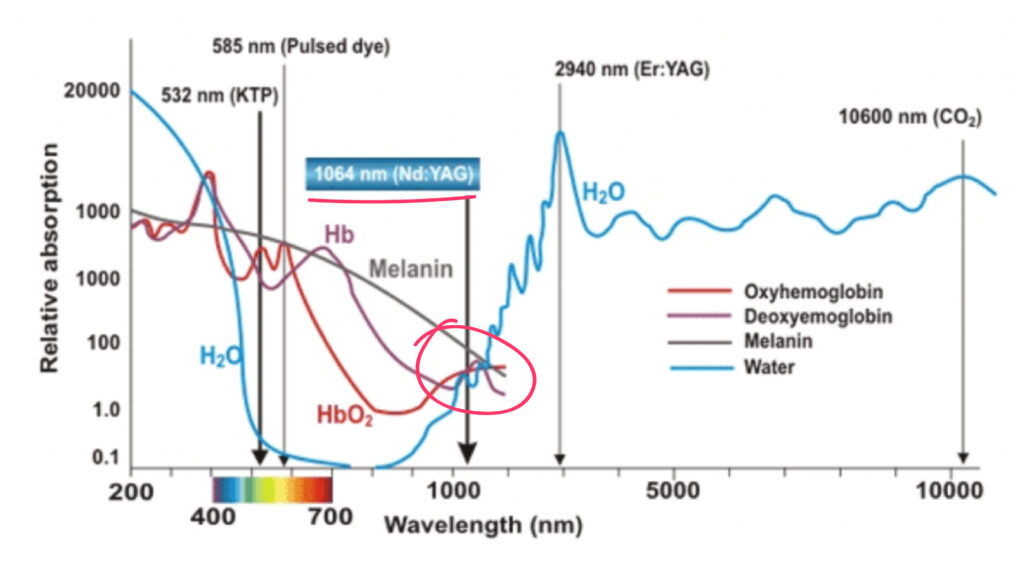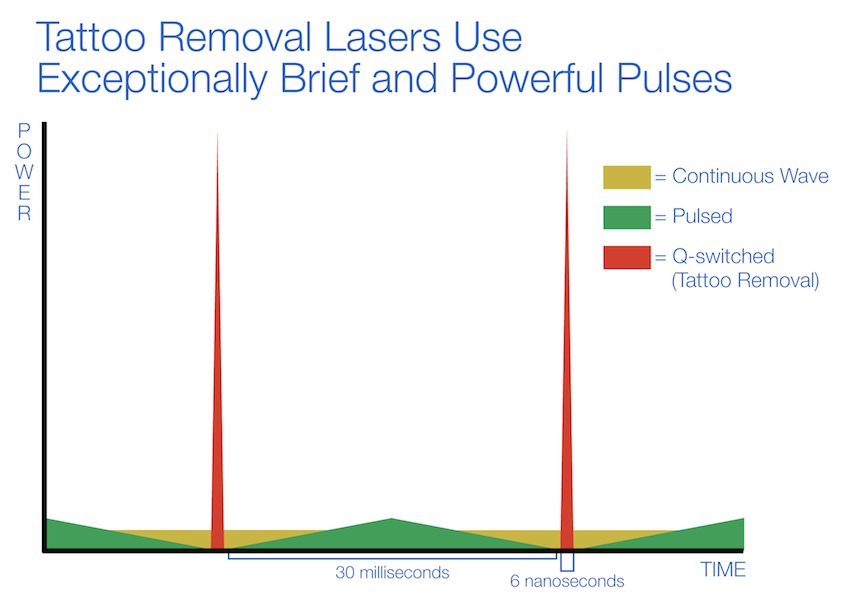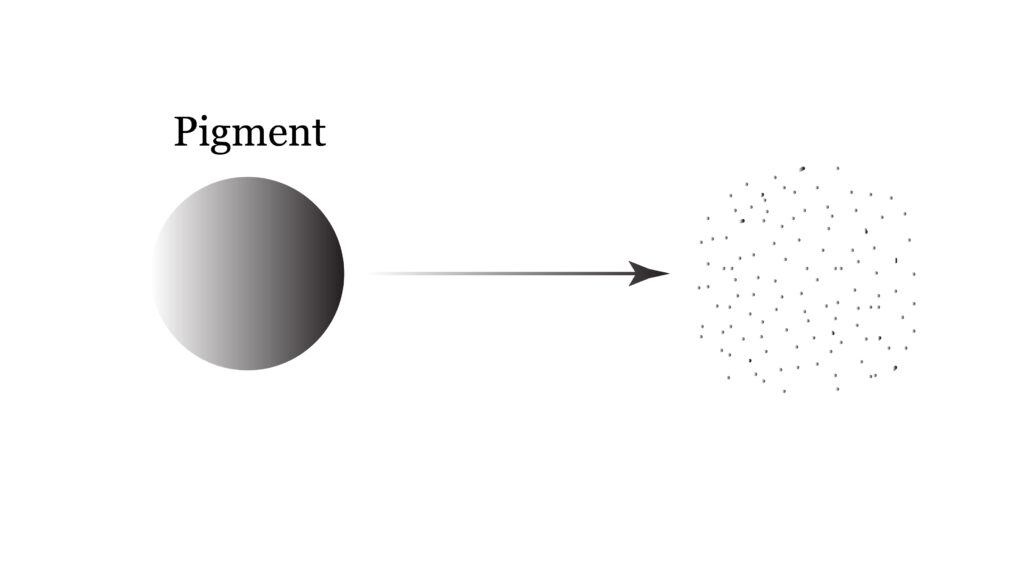How Laser Work on the Skin and How it Affect on the Pigments
Ok, Let’s continue)
With the advent of lasers, they have always tried to test on humans, animals, etc. to use in medicine. It all looked like an experience – we did, we looked at what happened. Any adequate response was not formulated. It happened only in 1983.
Anderson and Parrish published their concept of selective photothermolysis in the journal “Science”. The essence of the concept was that the effect of the laser beam on the tissue is carried out by finding in it chromophores that absorb a certain wavelength of radiation. The laser pulse duration corresponding to the thermal relaxation time of the chromophore should be taken into account.
Unfortunately, many artists to remove permanent makeup just try)
What is selective photothermolysis?
Selective comes from the word to select
Photo is light, thermolysis is destruction by heating.
Now selective photothermolysis is selective destruction by heating with light energy.
Photoepilators, tattoo and vessel removal lasers are based on this concept.
Ok, now what is a chromophore. The chromophore is a target in the tissues that we need to act on.
What can be the target in the tissues?
- Melanin
- Hemoglobin – when we work with vessels
- Collagen
- Water in the tissues
- Pigment artificially introduced into the skin – tattoo pigment
Our task is to destroy our target and not destroy everything else around and it is possible.
The first concept is that you need to choose the right wavelength of the laser. We need to choose a wavelength that will be optimally absorbed by our target and poorly absorbed by everything else around. Then we will be able to affect selectively our target and everything else will remain alive and will not suffer.
How to understand that? Let’s take a look at this table.

Targets we have known for a long time are oxyhemoglobin, water, melanin, deoxyhemoglobin. They have long been investigated for absorption, that is, what wavelength which target is well absorbed.
For example, water has peaks, the wavelength of 2940 nm which is used in Er: YAG Laser (erbium-doped yttrium aluminum garnet laser) is completely absorbed by water. This laser heats only water in the tissues, while other targets such as melanin, hemoglobin, practically do not absorb this wavelength.
This type of laser can work with water in the tissues and it does not matter whether the person is tanned, whether he has a pigment, vessels, etc.
Now let’s see where the neodymium laser is

The diagram shows that a neodymium laser with a wavelength affects all targets almost equally and it seems that there is no selectivity here. What to do in such a situation?
This is where one of the misconceptions lies. You might come across in the description to Nd: YAG Q-Switched lasers that it removes vessels rejuvenates the skin and does hair removal. This is completely wrong! All this can be done by a long-pulse laser!
So we finally come to the second part of selective photothermolysis. In addition to the wavelength, the laser pulse duration must be taken into account.
What does it mean?
To destroy our target, the laser pulse must be shorter than the target Thermal Relaxation Time (TRT). This is the time for which our target cools.
Thermal Relaxation Time – is the time during which the subject cools. This time depends on the size of the item. That is, a small object heats up quickly and cools rapidly. Obviously, a large object heats up longer and cools longer.
For example, boil a glass of water and a pot of water and leave them to cool. Naturally, a glass of hot water cools faster than a pot with water – this is just the difference in the thermal relaxation of the object.
Now, what does this have to do with lasers and pigment destruction?
There were attempts earlier and now are also present when the laser epilator accidentally touched the tattoo. Theoretically, a black tattoo should absorb any wavelength, in fact, it is. A laser epilator has a wavelength of 808-810nm if it is a diode laser. But one moment is not taken into account here – the pulse duration of laser epilators is specified in milliseconds 30-40-50 ms, while we have already said that the particle size of the tattoo pigment is in nanometers from 50-100 to 500 nm. What happens to these particles when we affect them with a pulse duration in milliseconds? There is a kind of heat on a slow fire) So, we heat this particle, it gets hot and burns the surrounding tissue and we get a burn on the skin. Nothing else happens to the particle, it’s both heated and cooled down. This is where the problem is when long-pulse lasers try to remove tattoos. Epilator lasers, Neodymium long pulse lasers, Ruby lasers, Alexandrite lasers can be long pulse lasers.
What is the advantage of lasers with which we work with you?
Have you paid attention to the word Q-switched written on lasers?
Q-switch is a technology that means Quality Switch is the essence of technology that allows us to switch the laser pulse duration from milliseconds to nanoseconds. For clarity, here is an example.

What is a nanosecond? A nanosecond is 1 second divided into 1 000 000 000, this is a very short period of time. What happens in such a short moment?
A particle of our pigment receiving such energy during such a period of time does not have time to cool down and it breaks.

It breaks the particle due to the difference in temperature. Let’s say we hit a laser beam in the upper part of the pigment particles, it is immediately heated and the lower part is heated later than the upper and because of this difference, the particle breaks into smaller fractions.
Why do customers feel pain during laser removal? Just because there is an explosion of pigment particles in the tissues. There is no burn but there is a mechanical injury of the tissues next to it that appears as redness and swelling. The more pigment in the skin the stronger the client will feel pain when removed.
Have you paid your attention to the power of your laser if you own one? Usually, it is about 1000 mJ. I just want to show you why it’s tearing the particle apart.
Let’s go like this:
1000 mJ is 1 J
1 J is a value that heats 1 gr of water less than a degree, so it is a little. But what happens if we compress it in a nanosecond period of time?
P (power)=E(energy)/t(time)
That is, we get such a function:
P = 1J/1*10-9
As a result, we get that the flash power that absorbs the pigment particle is P=1*10-9 W
Thus the power is about 1 000 000 000 W, for comparison, the power of the iron is about 2500 W). The power achieved by the laser during the flash is comparable to 30,000 – 40,000 included irons at the same time)) Therefore, our particle breaks into pieces)
There are picosecond lasers in which the flash pulse is not 10 to -9 degrees, but 10 to -12 degrees. The difference between picosecond and nanosecond lasers is that in picosecond lasers the destruction of the pigment comes from the acoustic impact, in a nanosecond from thermal.
I am telling this so that you understand that you are dealing with very serious instruments, as well as that you understand the physics of the process when working with a laser.
So what happens in the skin when the laser affects the pigment? The laser crushes the particle into very small parts and our immune system (macrophages) absorbs these particles without any problems and removes them from the skin. This is how the gradual fading of tattoos and permanent makeup looks.
In the process, there should be no burns, injuries, blood. We only need to crush the pigment, and the rest will be done by the immune system.
Ok, now we will talk about the factors affecting the safety of laser removal. Let’s move on to the next lesson.
